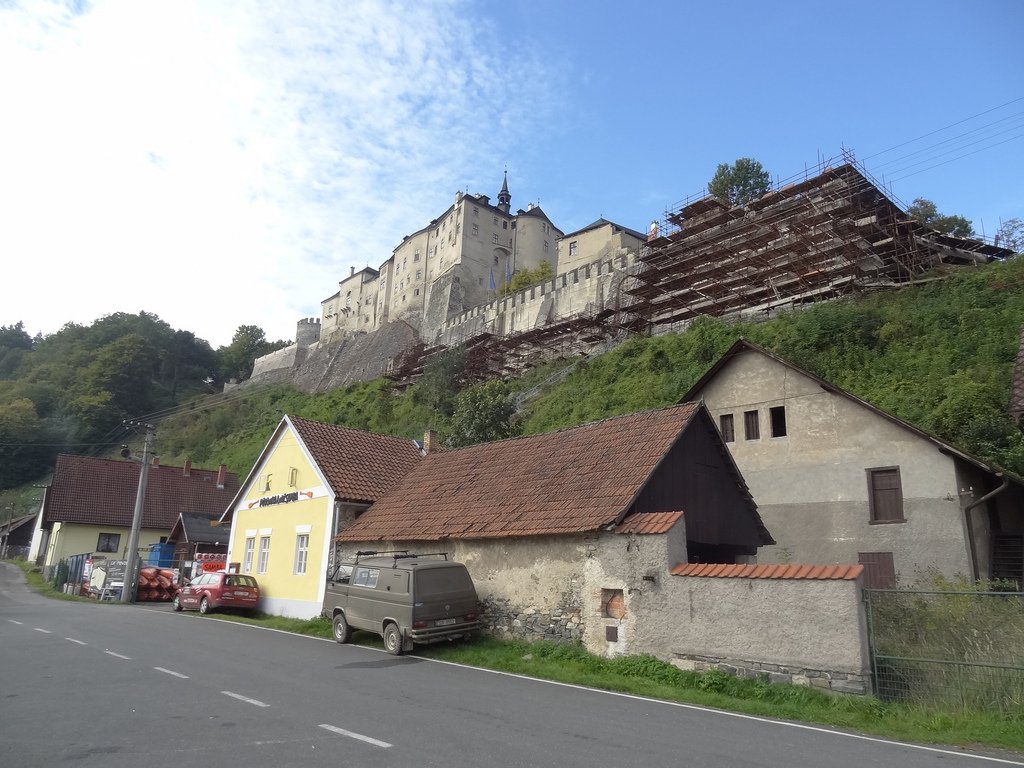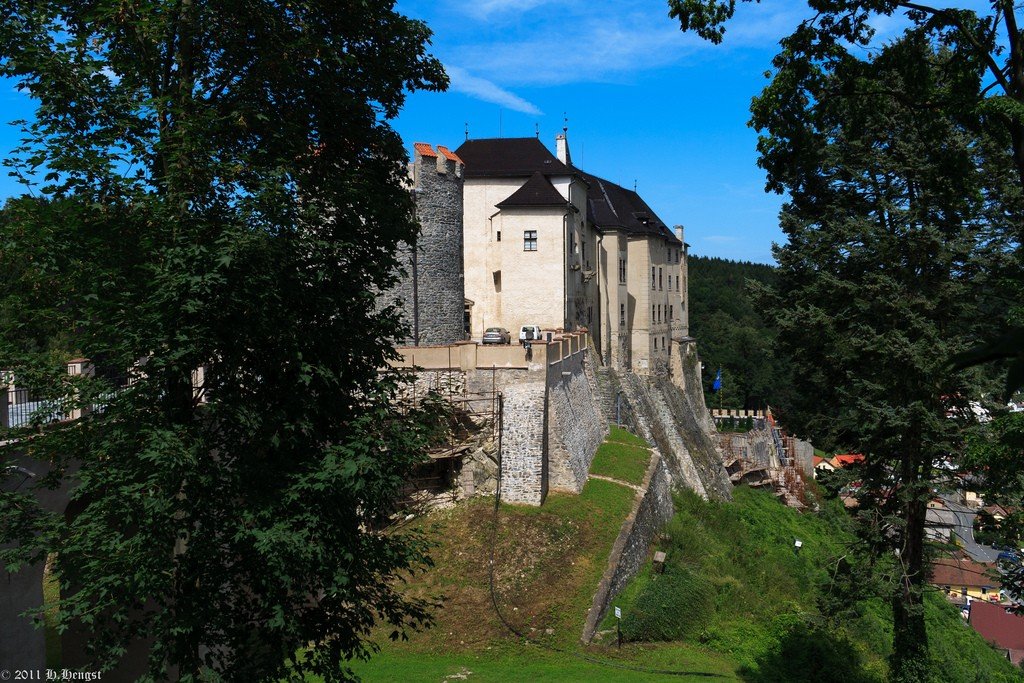Český Šternberk Castle
Český Šternberk Castle is a fortress in the heart of Bohemia, located on top of a cliff and overhanging the village on one side and the Sazava River on the other. In the Middle Ages, due to this position, the castle was considered impregnable.










Video: Cesky Sternberk Castle
ContentsHistory
Cesky Sternberk Castle was built by local aristocrat Zdeslav Dywiszowiec and was first called “The Pearl of Posazawa”. Then members of the Divišovc family, like many other Czech aristocrats, changed the surname in the German manner. The family coat of arms is depicted as a multi-pointed star on a blue background. The name of the coat of arms, translated from German as “starry mountain”, gave birth to the new surname Shterenberk, because the star in German – “stern”, the hill – “berg”. So now the Sternberk family is one of the aristocratic dynasties known since ancient times in Bohemia. At that time it was the most powerful fortress in Bohemia and was considered safe because of its impregnable terrain. The original Gothic style fortress is located on top of a high cliff overhanging directly over the banks of the beautiful Sazava River, near the town of Benesov. During the rains, the water in the river reaches the very edge of the banks, which only adds to the inaccessibility of the fortress walls.
.
Time passed. The castle changed most of all during the Hussite Wars, at that time the owner Zdenek Sternberk rebelled against the king, for which he was thoroughly destroyed and looted. Therefore, the owners decided to strengthen it, for which a new tower was added. The castle gradually deteriorated, so during the renovations the building lost its true Gothic features and acquired new ones as the tastes of the castle owners changed. For example, from 1693 to 1945, the Lichtenstein owners added a bit of Baroque, and in 1886 the Viennese architect K. Kaiser designed and supervised the construction of new castle facilities, changing the castle’s appearance with elements of Romanticism..In 1907, in just a couple of years, a park was developed near the castle. The castle suffered some damage during World War II, but after restoration it was reopened to the public in 1947.
.
In the southern part of the castle is the Gladomorna fortress bastion, an almost perfectly preserved example of Late Gothic fortifications. In the 16th century it was started to be built by Piotr Golicki Sternberk, but was not completed in time, so it was finished by his son Jan. The siege and capture of the castle in 1467 showed how weak the southern part of the castle was for defense, which is why this construction was started. It is separated from the castle by a gallery, and when it was placed on the hill it was fortified with stone structures. A spiral staircase leads to the top of the tower, from which you can fire through the shooting holes. The cellar here was used for storing guns. A horseshoe-shaped rampart was built around the bastion, but unfortunately it has not been completely preserved.
.
A remarkable fact is that since its foundation and to this day the castle has been inhabited exclusively by the Sternberg family. It is truly a unique castle, whose walls are “seen” by new generations of a single family, starting with the founder of the castle – Zdeslav. Today, however, the castle is not only a home for the Sternberg family, but also a source of income. You can take a guided walk here and even rent the premises for an old-style wedding.
.What to see
Cesky Sternberk Castle includes fifteen chic rooms and halls. From the threshold, tourists enter the Hall of Knights, where they can examine many historical exhibits. Then through the Chapel of St. Sebastian pass to the Yellow Salon, where you can admire the frescoes of the Baroque period and sit on furniture from the era of Louis the Fourteenth. The next rooms are the Women’s Salon and the Library. The castle library houses several thousand unique books and the walls are decorated with works by Peter Bradl. Next, guests are greeted by the Dining Hall, which houses a collection of portraits of the Sternberk family, as well as the family’s silverware and utensils. The tour continues through the Oriental-style entrance hall to the breakfast room, where a collection of silver figurines and statuettes is on display. In Jiří Sternberk’s study, the family genealogical tree of the family is displayed. It shows six generations of Sternberks in 63 portraits. The next four rooms are decorated in various styles, from rococo to baroque. The next room will not leave men indifferent, because here are the trophies from the Sternberks’ hunting trips. And at the front staircase, where the walk through the castle ends, it is impossible not to notice the painting by Philipp Sternberk, which depicts scenes from battles.
.
One of the collections illustrates the life of Prince Kašpar Sternberk, a famous Czech figure belonging to the National Renaissance. And, of course, the Cesky Sternberk’s celebrity is a collection of 545 copper engravings on historical themes. The events of the Thirty Years’ War are depicted on them according to Jiří Sternberk’s idea. The Gothic stone statuette, a family heirloom, displayed in the chapel dates back to the 14th century. The castle is overflowing with samples of ancient weapons of different epochs, and visitors are delighted by unique furniture, natural leather wallpaper, paintings by Dutch and Italian masters of the 17th and 18th centuries, fireplaces with tiles, exhibits of the Clock Museum and colored stained glass windows.
.The Legend of the Lost Treasure
Like any self-respecting castle, Cesky Sternberg is laden with legends. According to one of them, one of the counts very successfully sold one of the castles he owned, realizing a fortune for it – a chest full of gold. Finding no better use for his wealth, he took some of the gold with him on a long journey, and left some of it in the castle, entrusting his faithful servant Hynek to guard it. Hynek, unable to bear the burden of the responsibility he had been given and losing sleep, decided to hide the gold in the mountains. Just a few days afterward, he fell from his horse and soon died. Before his death, in a semi-conscious state, he tried to explain with gestures to the clerk where he had hidden the treasure, but the latter did not understand him. No matter how much they searched for the treasure in the castle and the surrounding area, they could not find it. Perhaps until now medieval gold somewhere in the vicinity of Český Šternberk is waiting for the lucky person who will be able to find it.
.Tourist information
A guided tour of the castle takes about an hour and is led by Count Zdenek Sternberk himself, who takes pleasure in telling the visitor about the complicated history of his family and the entire castle complex. The story can be told in different languages, but the cost of the tour in that case increases from 4 to 7 EUR. There is one nuance: the minimum group size is 10 people. If you don’t want to wait or your company is smaller in number of people, you will still have to pay for the tour as for ten people. Visitors are usually welcome from 9 a.m. to 5 p.m. (until 6 p.m. in summer), but for a fee of 10-11 EUR (per person, minimum group of 10 people) you can take an impressive night tour.
.The castle’s surroundings attract tourists. A small village with the same name calls for a hike. On weekends you can take a tourist train to it to the sound of an ancient steam locomotive. The way lies along the gorge of the Sazava River – Posazavskogo pacifica, famous for its picturesque view.
.
There is no need at all to return to Prague’s hotels for an overnight stay, as right across from Cesky Sternberk is the Parkotel. It houses 18 standard rooms for two or three guests with obligatory bathrooms. But only eight of them give a view of the castle from the windows.
.The hotel has a bar and a restaurant where chefs introduce tourists to authentic Czech cuisine. Lunch on the summer terrace will delight with the scenery of the hail. The hotel invites both tourists and business travelers to the Czech Republic. For seminars or conferences halls are open, equipment and office equipment is ready.
.You will not be bored in the department: paragliding, rafting, cycling, canoeing, mountaineering and sport fishing are waiting for vacationers. Ping pong, tennis, soccer, volleyball, billiards, darts and horseback riding are ready.
.The hotel’s banquets are accompanied by historical reenactments and programs, and guests are entertained by jugglers, fakirs, fire-eaters, and dancers.
How to get to Český Sternberk
Address: Český Šternberk 1.257 26 Český Šternberk, Czech Republic
Despite the proximity of the capital (it is only 50 km north-west of the castle) and the town of Benešov, which is a stopping point on the way to other attractions of the region, getting to Český Šternberk is not very convenient. That’s why many people prefer to take a tour in Prague. But the trouble is that guides often take a little time to see this castle, combining a visit to Cesky Sternberk with a trip to other castles. If you want to explore it in detail and thoughtfully, enjoy walking around and taking pictures, you have to go there yourself.
.By bus
The castle itself is located near the village of Cesky Sternberk, or rather, the settlement was once formed around the castle. This town can be reached from Prague by train or bus, for up-to-date information on which you can check out this excellent Jizdnirady website. When choosing a bus trip to Cesky Sternberk (departing from Roztyly bus station), pay attention to the fact that there are few direct buses and they take quite a long time (2-2.2 hours). But they cost 3-4 EUR for the whole route, together with the transfer, and, as a rule, there are no problems with it. If you combine a trip to Cesky Sternbeck with a trip to Karlstejn, or for some other reason you will get from Benešov, it will cost 1-2 EUR, take about an hour, and there will be many more direct flights.
.By Train
Traveling by train, alas, won’t save you from connections either. From Prague, either from the main train station (Hlavní Nádraží) or from the station in Benešov (Benešov u Prahy), you will have to change trains at Cercany station and from there you will have to go to Cesky Sternberk station. Travel time from Benešov is about 1.5 hours and the fare is 2.5 EUR, the trip from the capital takes 2 hours and costs 4 EUR.
.